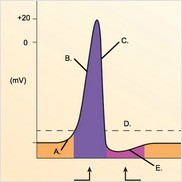Which of the following choices lists a correct sequence of events following the depolarization of transverse tubules in excitation-contraction coupling in cardiac muscle?
A. calcium release into cytosol, calcium ion influx through sarcolemma, actin and myosin attach, thin filaments slide toward the middle of sarcomeres
B. actin and myosin attach, thin filaments slide toward the middle of sarcomeres, calcium release into cytosol
C. calcium release into cytosol, actin and myosin attach, calcium ion influx through sarcolemma, thin myofilaments slide toward the middle of sarcomeres
D. calcium release into cytosol, actin and myosin attach, thin filaments slide toward the middle of sarcomeres, calcium ion influx through sarcolemma
E. calcium ion influx through sarcolemma, calcium release into cytosol, actin and myosin attach, thin myofilaments slide toward the middle of sarcomeres
E
You might also like to view...
In a condition known as posterior vitreous detachment, the vitreous body pulls away from the retina. What is a complication that could result?
A. Retinal detachment B. Glaucoma C. Macular degeneration D. Chronic dry eye disease
Urine leaves the renal pelvis and enters the ureter because of
A) contractions of the muscular layers of the renal capsule, which squeeze the kidney. B) opening of valves into the entrance of the ureters, which permits urine to flow through them passively. C) peristalsis of the ureters. D) gravity. E) All of the answers are correct.
____________________ helps in the process of blood coagulation.?
Fill in the blank(s) with correct word
 The figure illustrates changes in the membrane potential during an action potential. What does "E" represent?
The figure illustrates changes in the membrane potential during an action potential. What does "E" represent?
A. Local potential B. Depolarization C. Repolarization D. Afterpotential E. Threshold